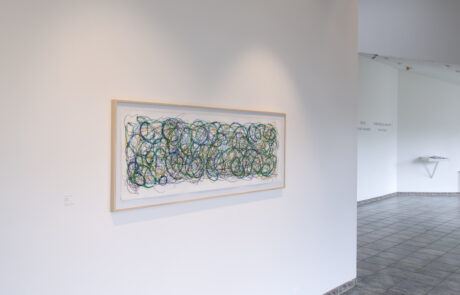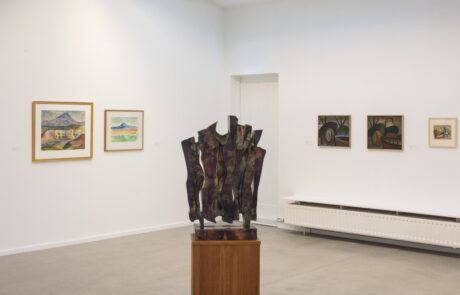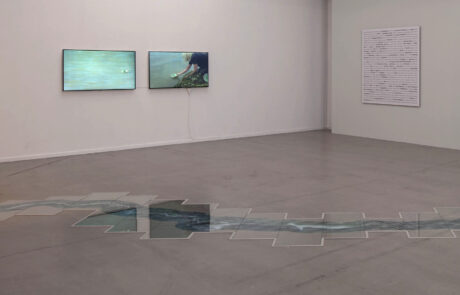
Water on land
Borghildur Óskarsdóttir
March 10 – May 10, 2018
Æsa Sigurjónsdóttir
Walking the banks of the Þjórsá river with Borghildur Óskarsdóttir
Environmental art has been defined as art in a public space which takes account of a specific environment, or is closely linked to a certain place and its natural attributes. In recent decades Borghildur Óskarsdóttir has been engaged in a range of research projects relating to her family history. She has inched her way back in time, like a genealogist seeking out the truth of her origins; the quest may perhaps be identified with the obsession that French philosopher Jacques Derrida called modern man’s irrepressible desire to return to the origin. In the exhibition MH-30, marking the 30th anniversary of the Reykjavík Sculpture Association in 2002, she arranged portrait photographs of her maternal relatives in a circular shape on a blue ground, like a galaxy in the night sky, under the title Maternal Patterns. She has presented her relatives’ history in photographs, video, installations and texts, and in addition in performance art with ceramic bowls, reminiscent of sacrificial rituals in honour of ancestors.
In her Threads on Land, shown at the Reykjavík Municipal Library at the Reykjavík Arts Festival in 2014, Borghildur presented the results of her detailed exploration of the life and home territory of her paternal family in inland Rangárvallasýsla, south Iceland. She started by leading the viewer to overgrown ruins of a house at Reynifell below Mt. Þríhyrningur, where her ancestors Þorgils Þorgilsson and Guðrún Erlendsdóttir settled in 1760. Three of their descendants later moved to the Land district; one of these was farmer Jón Finnbogason of Mörk, Borghildur’s great-great-grandfather. She explores the family’s residential history in an ecological context, and recounts the gruelling life of her great-grandparents, Höskuldur and Arndís Magnúsdóttir, from the time they set up home on the estate of Mörk. From there they moved on to Stóri-Klofi, but soon had to move on due to encroaching sands. Abandoning the attempt to farm in their own right, they became bonded farm labourers in Biskupstungur, while their surviving children had to go into foster care, as was the custom of the time. They then returned to their home region and started to farm again, on the abandoned farm of Gamla Skarðssel, where they made themselves a shelter in an open cave, built a small cattle shed and found a water source. They reclaimed their children, but once again they were forced off the land by encroaching sand which filled up all the hollows and polluted the spring. They moved their buildings west to the banks of the Þjórsá river, and rebuilt Skarðssel there in 1893-94. Their final years were spent living with their son and daughter-in-law at Skarfanes, where farming continued until 1941, when the family moved to the city.
A similar fate awaited her grandparents, Bjarni Bernharðsson and Ragnhildur Höskuldsdóttir, and their seven children. Borghildur told their story in her Are They Expecting Us? at the LÁ Art Museum in Hveragerði in 2008. After the Great Frost Winter of 1918 the family lost their home in Hafnarfjörður, and had to return to their home district of Gaulverjabær to claim poor relief. Their children were sent as paupers to live on various farms in the district. In the same work the artist followed the story of one of those children – her father, Óskar Bernhard Bjarnason, who at the age of six was placed in foster care on the farm of Efri-Gegnishólar. He was Borghildur’s principal source of information about these events.
Strands on Land is thus both a subjective narrative work and a site-specific environmental work based on detailed charting of the peregrinations of the artist’s forebears, accounts of their quest for a secure home, their hardships and the dangers posed by forces of nature – given form by Borghildur in seven memorials on the sites of the farms of Reynifell, Mörk, Gamli-Klofi, Stóri-Klofi, Gamla-Skarðssel, Skarðssel by the Þjórsá river, and Skarfanes. These are stone slabs, all oriented northeast-southwest, parallel to the lines of the surrounding landscape, inscribed with brief accounts of her relatives’ lives and tribulations.
The following year, 2015, Borghildur turned to a more mundane and physical proximity with her ancestors in her installation Quilt with an Old Cover, a video/text work based on the probate inventory of the property left by farmer Jón Finnbogason of Mörk on his death in 1859. His estate included various items which were given a monetary valuation and indicate that he was relatively prosperous. In the work Borghildur plays with the texture and symbolism of the words, which she spins together into verse. The objects on the farm included: “horses, hymns and quilts/slatted boxes, casks and meat/pack-saddles, a premature calf/floorboards and a trout net.” The culture of these people was so intimately entwined with the land and its nature that language and poetry effortlessly pervade Borghildur’s chants, helping the observer to sense where the artist is going, and her subjective space. She finds voices from the past, and various spectres and memories inhabit her family works, which form an ensemble, like chapters of a book. Solitary words evoke daily life, a world that appears bright and open, in harmony with nature, contrary to the image we have of poverty in the past.
Borghildur’s study of the history of her paternal family, first shown in the ASÍ Art Museum in 2007 as Double-page Spreads – Stories of Past Times in Light of Pictures, has gradually evolved into an extensive work of ecological art, with detailed exploration of people’s immediate environment and respect for the cultural heritage. In the last few years the artist’s perspective has grown more political, and she was motivated, for instance, by public debate on proposed harnessing of the Þjórsá river and the consequences for the surrounding area, to make Environmental Impact Assessment for Skarðssel on the Þjórsá river, shown in Reykjavík City Hall in 2016. Borghildur reported on archaeological excavations on the farm site of Skarðssel, one aspect of the mandated environmental impact assessment for the proposed Hvammur hydro plant in the Þjórsá river, as the ruins of Skarðssel are due to be obliterated by construction of the dam – if it is built – and the landscape will be transformed.
In Þjórsá Borghildur adds a new chapter to her opus, placing her study of her family history into a phenomenological context. The emphasis is no longer on the genealogy and accounts of the struggle with the encroaching sands, but on the direct connection in nature between consciousness and the environment. She focuses the viewer’s attention on the Þjórsá river, the longest in Iceland, which rises at the north of the barren central uplands to flow southwards across the country to the sea. The Þjórsá is a mixed spring-fed and glacial river, which is thus milky-white and fertile – the enigmatic artery of the ecosystem. The surrounding mountains are magnificent, and Borghildur uses both an all-seeing panoramic viewpoint and the individual view of the wayfarer in order to communicate what is seen. The dual perspective (close and distant) and the wealth of natural sounds heard in the installation bring reality closer and intensify the observer’s sensation: water gurgles, we hear the soughing of wind through the grass, and birdsong. The work is thus also a phenomenological audio work, which makes the observer conscious of time passing, despite the sensation of being in a space where time stands still.
Nature is constantly changing, and in this work Borghildur adopts the viewpoint of eco-phenomenology, thereby focusing on her experience and perception of the river and the ecology of the area around the ruins of the farmhouse at Skarðssel, on the east side of the river, where clear traces of the presence of her relatives still remain. In the work she mediates light, colour, movement, sound, texture and other qualities of the environment, which have a strong aesthetic appeal. Birdlife, vegetation and overgrown ruins of human habitation harmonise in the embracing landscape, with sublime mountains on the horizon. Her phenomenological approach to the environment sheds light on, and strengthens, her eco-aesthetic perspective, which she communicates to the observer in the certainty that knowledge is always to be found in first-hand experience of reality. The visual material and sound thus reinforce her personal connection with the place, and the observer senses her quest for the profound feeling arising from having a home. At the same time the observer grasps what qualities of the environment the artist sees as important.
But, despite the observer’s powerful experience of nature in the multiple perceptual spaces of the work, Þjórsá is primarily a political work which addresses one of the major issues of our time: the assessment of the conservation value of nature. While the declared objective of the work is to promote a local awakening about the importance of the ecology of the riparian zone by the river and the nature and cultural heritage sites in the adjoining regions, Borghildur succeeds in going a step further and opening up her study into the public debate on nature conservation in the bigger context. The work is thus a logical continuation of her previous studies of the family’s abodes, and supports growing demands in society for public bodies to carry out holistic evaluation of the country’s natural resources – demands which are increasingly hard for politicians and businesses to evade. Þjórsá thus raises questions about which aspects or attributes of nature society wishes to unite in deeming of value.
Borghildur’s eco-friendly perspective is predicated upon humanity not being apart from nature, but part of it, and sharing responsibility for the environment. Borghildur appears to side with those thinkers who believe that our ancestors – past generations, or phantoms in our life – have returned to remind us of them, in a world that appears to be moving ever further from the moral standards of human society and fairness to those who come after us. In that way Þjórsá poses questions about fairness and respect, not only vis-à-vis those who once lived by the river, but also with regard to conservation of an ecosystem for which society is responsible.
Earth has more than one meaning: both the soil beneath our feet, and our planet itself (in Icelandic the word jörð has even more meanings, including land and farm). Borghildur’s environmental art must be viewed as part of the tendency of ecological and political art in recent decades towards a post-humanist approach, an understanding of nature as an autonomous phenomenon which deserves our undivided attention. Her environmental and genealogical works are conducive to undivided awareness of reality, as in them the observer senses that value is rooted in everyday experience, and that a beautiful landscape is far from being the only argument for recognising the value of nature. Þjórsá thus raises even more exigent questions about the source of value, the conservation value of nature, and the responsibility entailed by safeguarding certain sites for the future.
About the artist: :
Borghildur was born in Reykjavík in 1942. She studied at the Icelandic College of Arts and Crafts (forerunner of the Iceland Academy of the Arts) 1959-60 and at Edinburgh College of Arts, Scotland, 1961-63. In 1973 she gained a teaching qualification from the Icelandic College of Arts and Crafts. She taught art for 3 years in elementary school and 10 years at the Reykjavik School of Visual Arts, while also working on her own art. But she has mainly worked as an independent artist. Borghildur has predominantly worked in three dimensions, initially mostly in clay, but she has since moved on to work in a range of materials, according to the nature of the subject. Her latest works relate to research into her own family history. During her long career she has exhibited extensively in Iceland and abroad, including New York, Canada, Poland, Scandinavia and elsewhere. Works by Borghildur are found in private collections and in the collections of public institutions and museums.
Borghildur is a member of the Association of Icelandic Visual Artists and the Reykjavík Sculpture Society, and has been elected to various offices within them.




